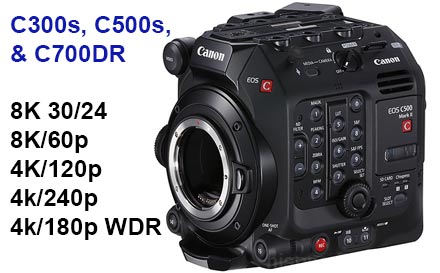Canon it seems is thinking 3 steps ahead of everyone else when it comes to pro 8k video. After being left behind in the adoption of 4k and playing catch up to the format, they seem intent on making their cameras the new 8k default option with specs that seem out of a dreamer’s wish list. Be warned that these cameras will probably start at $10k USD and go up from there. The low end should be about 10k to $15k for the C300s at the low end, and the high end a $30k price tag for a C700DR.
The most impressive of the new rumored cameras is the Canon EOS C700DR (DR Stands for Dynamic Range) which will be capable of recording 4k not just at 120fps but a class-leading 240fps with excellent quality. It also hints at a 180fps mode that will have expanded dynamic range if needed. It is interesting that 1080p as a slow motion mode is not even considered here but these cameras are geared to a specific market and that is digital cinema which needs much more resolution nowadays than what even 2k can deliver, much less 1080p.
Canon EOS Cinema Line Gets Big Upgrade:
The Canon cinema series has been dominating the rental cinema market since the debut of the original C300, now they are gearing the market for full 8k adoption and higher frame rates in 4k which can only be good for democratizing higher fps in ever-higher resolutions. The days of having 1080p as the best you could hope for mid-range commercial slow motion are nearing an end. 4k will be the next frontier and it seems 2021 will break the 240fps barrier in 4k as a format that is now available on mainstream production cameras.
The following rumored specs are based on this article by Canon Rumors and are considered quite solid by their standards. However final specs are subject to change.
Canon Cinema EOS C300S
- 8K Super 35mm
- 8K/60p, 4K/120p in all modes
- BSI Stacked 3.2um 8K DGO Sensor
- Dual Pixel Autofocus
- 16 Stops Dynamic Range in DGO Mode
- 10ms Readout in 8K DGO Mode
- Dual DIGIC DV 8 Image Processor
Canon Cinema EOS C500S
- 8K Full Frame
- 8K/60p, 4K/120p in all modes
- BSI Stacked 4.65um 8K DGO Sensor
- Dual Pixel Autofocus
- 17+ Stops Dynamic Range in DGO Mode
- 10ms Readout in 8K DGO Mode
- Dual DIGIC DV 8 Image Processor
Canon Cinema EOS C700DR
- 4K Full Frame
- 4K/240p in Fast Mode, 4K/180p in WDR Mode
- BSI Stacked 9.6um 4K WDR Sensor
- 20+ Stops Dynamic Range in WDR Mode
- 5ms Readout in 4K WDR Mode
- Dual DIGIC DV 8 Image Processor
Yes, you read that right, these cameras will allow for 8k 50/60fps capture in wide dynamic range up to 20 stops in the C700DR. 20 stops is nearing the ridiculous lever and goes to show that Canon’s dual photosite gain capture technology of DGO (DUal Gain Output) which uses stacked sensor photosites to record the same image at two different ISOs at the same time and then doing a merge n post to generate a true to life super wide dynamic range final image.
Some videos talking about the new rumored cameras below:
8K 60, Dual Gain, Back Illuminated, 240 fps by Ordinary Filmmaker:
3 New Cinema Cameras | Canon is not Playing | 8K60p and 20+ Stops of Dynamic Range by James Jackson Films:
New Generation: Canon’s Next 3 Cinema Cameras by Crimson Engine:
There is a lot of technology that is coming into the camera world that deals with high resolution and higher frame rates. It is clear that the days of a few companies like Vision Research dominating high frame rates at 4k are coming to an end. In time 8k 240fps will probably show up by 2025 at this rate which means 4k 480fps could become a common spec on midrange video cameras and electronic Viewfinder EVIL Gear as well. The good news here is that high frame rate enthusiasts will have even more options and better quality going forward, the only downside will be the higher price at first which should taper down as technology matures. There are also rumors of a Panasonic GH6 8k to be launched this year at the 20th year Anniversary of Lumix Cameras in early September. This camera should have a new sensor capable of high dynamic range and low noise while emphasizing 8k resolution with windowed slow motion modes. More info as things evolve, thanks for reading -HSC

